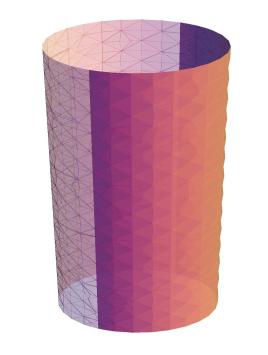By Diego A. Carranza and Juan A. Valiente Kroon
Maldacena’s AdS-CFT correspondence has brought the study of properties of anti de Sitter-like spacetimes (AdS spacetimes for short) to the centre of attention of a wide community of researchers. This class of spacetimes is characterised by a time-like conformal boundary similar to that of the anti-de Sitter spacetime. Maldacena’s correspondence relates AdS spacetimes to dual conformal field theories defined on the boundary of the spacetime. In particular, it allows to obtain information otherwise not easily accessible about the conformal field theories through the numerical computation of the dual spacetime. Thus, numerical simulations of these spacetimes have received a substantial amount of attention in recent years. The existence of the time-like conformal boundary in these spacetimes also has implications of interest to mathematicians studying general properties of solutions to the Einstein equations. AdS spacetimes are examples of non-globally hyperbolic solutions to the Einstein field equations. Accordingly, if one wants to formulate a well-posed initial value problem for an AdS spacetime, in addition to the initial data, it is necessary to provide some information on the boundary. The prescription of boundary data is linked to the question of stability of this kind of solutions to the Einstein equations as, during the last years, numerical evidence has showed that under certain boundary conditions the anti-de Sitter spacetime is unstable under non-linear perturbations.

Conformal embedding of the AdS
spacetime in the Einstein cylinder.
It has long been argued that the natural setting for the systematic study of AdS spacetimes is that of Penrose’s conformal compactifications whereby the time-like boundary is located at a finite distance in an unphysical (i.e. conformally scaled) spacetime. Together with the Minkowski and the de Sitter spacetime, the anti-de Sitter spacetime constitute the basic models of Penrose’s classical notion of asymptotically simple spacetimes —that is, spacetimes admitting a smooth conformal compactification. In 1995, as part of his long-standing programme to understand the deep relation between the Einstein field equations and Penrose’s notion of conformal compactification, Helmut Friedrich studied the construction of anti-de Sitter spacetimes in terms of an initial-boundary value problem for his conformal Einstein field equations —a conformal representation of the Einstein field equations which renders regular equations up to the conformal boundary. This was the first systematic study of boundary value problems for the Einstein equations and showed that the construction of AdS spacetimes allowed for a quite general class of maximally dissipative boundary conditions which include, as a particular case, reflective boundary conditions. Remarkably, for a certain subclass of the boundary conditions it was possible to show that they were equivalent to prescribing the conformal class of the metric on the boundary. Unfortunately, the particular method and boundary conditions used in this analysis are not readily amenable to a numerical implementation.
Motivated by the last point, in our recent article we provide an alternative formulation of the initial-boundary value problem for AdS spacetimes, also based on conformal methods, which we expect to be more amenable to a numerical implementation and which would require only minor modifications to current mainstream codes. The main ingredients of our construction are the following:
- the use of a set of generalised wave coordinates,
- the fixing of the conformal gauge by the Ricci scalar,
- a system of wave equations for the conformal fields,
- boundary conditions which allow to prescribe a combination of the incoming and outgoing components of the Weyl tensor.
As the main result of our work, the theory of partial differential equations for initial-boundary value problems guarantees that it is possible to locally construct an AdS spacetime. In our formulation, the evolution equations can be thought of as the Einstein field equations (for an unphysical metric) coupled to some exotic matter field which, in turn, satisfies a set of wave equations. This observation suggests that the numerical implementation may only require minor modifications to current numerical codes.
Given the relevance of AdS spacetimes to different communities, we expect our work to be of great interest for those working on mathematical and numerical relativity, as well as those involved in theoretical physics. The extension of our work to accommodate a range of trace-free matter models, such as the Yang-Mills and the conformally invariant scalar fields, is currently underway.
Read the full article in Classical and Quantum Gravity:
Construction of anti-de Sitter-like spacetimes using the metric conformal Einstein field equations: the vacuum case
Diego A Carranza and Juan A Valiente Kroon 2018 Class. Quantum Grav. 35 245006
About the authors:
Diego A. Carranza is a PhD student at Queen Mary University of London, working under the supervision of Juan A. Valiente Kroon on conformal analysis of adS-like spacetimes.
Juan A. Valiente Kroon is Reader in Applied Mathematics at Queen Mary University of London and author of a monograph on the use of conformal methods in General Relativity.
Sign up to follow CQG+ by entering your email address in the ‘follow’ box at the foot of this page for instant notification of new entries.
CQG papers are selected for promotion based on the content of the referee reports. The papers you read about on CQG+ have been rated ‘high quality’ by your peers.
This work is licensed under a Creative Commons Attribution 3.0 Unported License.



You must be logged in to post a comment.